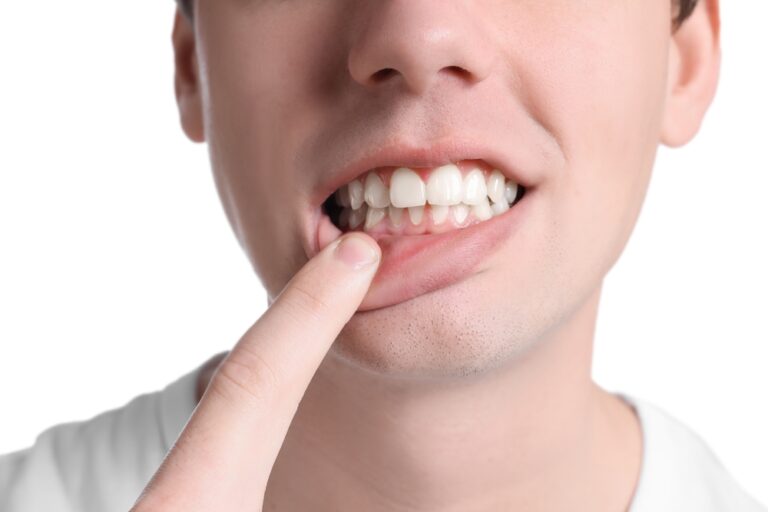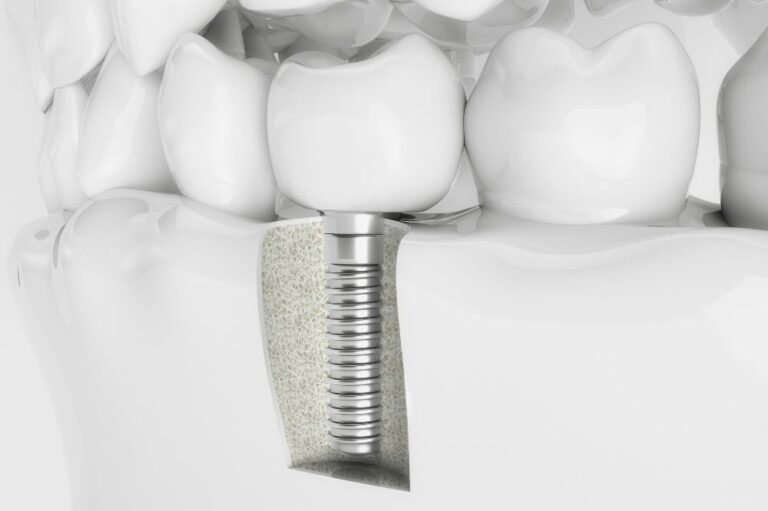What are braces and how do they work?
Braces are orthodontic devices that help move teeth into proper alignment. They are typically made of metal or ceramic brackets that are bonded to each tooth, then connected with an archwire that applies gentle pressure to shift teeth into desired positions over time.
Braces work by placing controlled forces on specific teeth to gradually reposition them. The archwires integrate with the brackets on each tooth to move teeth up or down, rotate or tip them, and close spaces. Archwires are changed periodically by an orthodontist during treatment to alter the forces as needed while the teeth slowly adjust to their new alignment.
Treatment length depends on the complexity of the case and how much movement is required. On average, braces are worn for 18-24 months. With severe alignment problems,expanders may be used first to widen the jaw prior to braces or teeth may need extraction to create room for shifting.
Regular adjustments are a key part of braces. Every 4-6 weeks, you’ll need a short appointment for your orthodontist to change the archwires and elastic ties to maintain pressure moving teeth into better positions. New archwires with different thickness or shape are used to progressively reposition the teeth based on the treatment plan.
Who should consider getting braces?
Braces are effective for correcting various alignment issues in both children and adults, including:
For kids:
- Crowding – Teeth coming in crooked overlapping each other
- Misaligned jaws – Upper and lower teeth meet improperly
- Spacing – Abnormal gaps between some teeth
- Crossbite – Upper and lower teeth are misaligned
- Underbite/overbite – Vertical misalignment when biting down
- Impacted teeth – Teeth stuck and unable to erupt
For adults:
- Crowding or crooked teeth
- Spacing between teeth
- Misaligned bite and jaw pain
- Increased risk of damaged/broken teeth
- Periodontal disease from teeth crowding
- Difficulty cleaning teeth effectively
- Self-image concerns from crooked teeth
The American Association of Orthodontists recommends every child have an orthodontic assessment by age 7 to spot problems early. Early treatment may be recommended in severe situations where growth modification is needed or to prevent complications.
For adults, there is no upper limit on age to get braces! As long as you have healthy gums and bone structure, braces can be effective. About 1 in 5 orthodontic patients today are adults interested in improving their smile.
When is the best time to get braces?
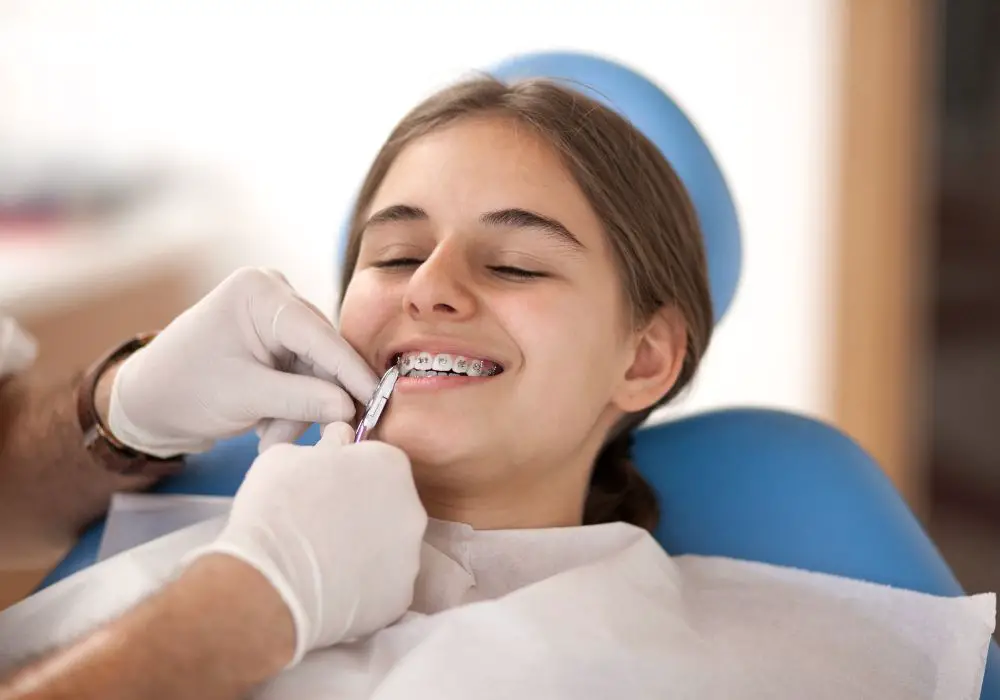
For children – The ideal time for braces is between ages 8-14 while the head and mouth are still growing. Early intervention prevents more serious issues from developing and can reduce treatment times. However, braces can be effective even into the late teens depending on the problems present.
For adults – There is no “best” time since treatment is effective at any age. Some adults who couldn’t get braces as a child make it a priority once they have the means to afford treatment. Others seek orthodontic help later in life after noticing changes in their bite, experiencing jaw pain, or becoming dissatisfied with the look of their smile over time.
How to get braces: the process
If you’re wondering how to go about getting braces, the typical process involves:
- Orthodontic evaluation – Get a checkup to determine if braces could help you and what treatment may be required. X-rays, photos, impressions for study models, and a computer scan may be done to fully assess your specific case.
- Consultation – The orthodontist will explain your treatment options and recommend a plan. You’ll also discuss cost/insurance, length of treatment, extractions, orthognathic surgery risks, and choice between types of braces.
- Records appointment – In-depth records will be taken including x-rays, photos, impressions of your teeth, and a scan of your mouth. This data helps plan the precise treatment.
- Braces fitting – During this visit, the orthodontist will bond the brackets onto each tooth, then thread the initial archwire through connecting the full set of braces.
- Regular adjustments – Braces must be tightened every 4-6 weeks by changing the archwires and applying forces to continually shift teeth into better alignment.
- Retention – After braces come off, you’ll need to wear a retainer full-time, then nightly to hold newly straightened teeth in position while the gums and bone stabilize.
The process takes place over 12-24 months for mild to complex cases. Keep all adjustment appointments for successful treatment. Alert your orthodontist of any issues right away.
Finding an orthodontist
Choosing a skilled, trustworthy orthodontist is key to achieving the best results from your braces. Options to find an orthodontist include:
- Ask your general dentist for recommendations of excellent local orthodontists.
- Search the Find an Orthodontist tool provided by the American Association of Orthodontists.
- Check which orthodontists are covered by your dental insurance plan.
- Ask for referrals from friends, relatives, neighbors, or coworkers who’ve had great experiences.
- Search online reviews and compare highly rated orthodontists in your area.
When selecting an orthodontist, look for proper education, several years of experience, board certification, and positive patient reviews. Meet with a few orthodontists for a consultation to find one you are comfortable with.
Braces cost with and without insurance
The costs of braces can range quite a bit based on these factors:
- Type of braces – metal, ceramic, lingual or Invisalign
- Extent of misalignment needing correction
- Length of treatment time
- Orthodontist’s fee rates for braces procedures
Here are the average costs for common types of braces:
- Metal braces – $3,000-$7,000
- Ceramic braces – $4,000-$8,000
- Lingual braces – $8,000-$10,000
- Invisalign aligners – $4,000-$8,000
Many dental insurance plans help cover braces for children and adults with orthodontic benefits. Check your plan details, but coverage may include:
- 50%-100% of braces costs up to a lifetime limit or set dollar amount
- No deductible for orthodontic benefits
- No limit on the number of covered orthodontic visits
- Up to 24 months of treatment covered
For uninsured patients, orthodontic payment plans and financing can make braces more affordable through monthly payments. Discuss options at your orthodontist consultation.
Non-profit and donated orthodontic care may be options for those who cannot afford braces otherwise. Dental schools also offer discounted braces performed by students overseen by professors.
Types of braces to consider

There are several types of braces with varying benefits when it comes to appearance, discomfort, effectiveness, and cost:
Metal braces
- Most common and affordable option
- Very effective for correcting bite issues
- Silver metal brackets bonded to each tooth
- Use metal archwires tightened at each visit
- Show up opaque but can add color elastic bands
- No dietary restrictions
Ceramic braces
- Made of clear or tooth-colored ceramic brackets
- Less visible but still apparent if you look closely
- Cost more than metal braces
- Can appear stained compared to teeth
- May be less effective for complex cases
Lingual braces
- Custom fit to back of teeth so not visible
- Completely hidden from view
- Effective for moderately crowded teeth
- Very difficult for proper cleaning
- Cause speech impediment initially
- Significantly more expensive
Invisalign aligners
- Clear plastic trays worn over teeth
- Subtle appearance that can be hard to notice
- Easily removed for eating, brushing, flossing
- Not suitable for certain bite problems
- Trays replaced with new ones every 1-2 weeks
Discuss which braces type makes the most sense for your situation with your chosen orthodontist.
Maintaining good oral hygiene
Excellent oral hygiene is critical during orthodontic treatment to prevent tooth decay, gum disease, and permanent markings on teeth. Braces with brackets and wires trap more food and plaque. Thorough brushing and flossing is a must.
Brushing effectively
- Brush after meals and before bed with fluoride toothpaste
- Spend 2-3 minutes carefully brushing each tooth surface
- Use special orthodontic brushes to clean braces better
- Ensure you adequately clean along the gumlines
Flossing thoroughly
- Floss at least once daily, gently guiding it between each tooth and under the braces
- Flossing picks and threaders help access tight spaces
- Water irrigation devices remove debris floss can’t
Other hygiene tips
- Use interdental brushes to clean under brace wires
- Rinse daily with an ADA-approved fluoride mouthwash
- Get professional cleanings every 6 months
- Avoid sugary and acidic foods that increase decay risk
Extra time and tools are required for sufficient hygiene with braces. Alert your orthodontist of issues. White spot lesions that form can become permanent without quick intervention.
Risks and potential side effects
While generally safe, braces also come with some risks and possible side effects to be aware of:
- Tooth decay and permanent white spots from inadequate cleaning
- Gum inflammation, infection, and recession without proper hygiene
- Shortened tooth roots in rare cases from repositioning
- Worsened TMJ/TMD pain from bite adjustment
- Cheek and mouth sores from bracket edges
- Enamel damage if improper removal occurs
- Teeth shifting after braces without retainers
- Jaw joint discomfort or pain from adjustment
- Allergic reactions in extremely rare cases
Discuss any side effects or issues that develop with your orthodontist promptly to determine needed adjustments or solutions. Being diligent with oral hygiene and following all instructions closely helps minimize risks.
Answers to common questions about braces
Here are answers to some frequently asked questions people have about getting braces:
Are braces painful?
Braces can cause temporary soreness for 3-5 days after initially getting them on and after each adjustment appointment. Over-the-counter pain medication helps relieve any mild brace discomfort.
How are braces tightened?
The orthodontist removes the tiny elastic bands around each bracket then takes out the archwire. A new archwire is inserted and secured with new elastics to maintain forces moving teeth. This is done every 4-6 weeks.
Can I play sports with braces?
Yes, you can play sports with braces but a custom mouthguard is recommended for kids in contact sports like football, soccer, wrestling and lacrosse to prevent injury. Alert your orthodontist of any damaged brackets.
What foods can’t I eat with braces?
Avoid very hard, sticky, crunchy or chewy foods that can break braces like ice, nuts, popcorn, gum, licorice, carrots, pizza crust, hard candy, and chewing pens.
How long until I get my braces off?
The average braces treatment takes 18-24 months but could be shorter or longer ranging from 12-36 months depending on your specific case. Your orthodontist determines when your teeth have been corrected enough for brace removal.
Conclusion
While braces take commitment, excellent hygiene, patience, and often insurance benefits or other financing to afford, they provide the ability to straighten teeth and improve smiles for both children and adults. Work closely with an experienced orthodontist and follow instructions carefully throughout treatment for best results.


